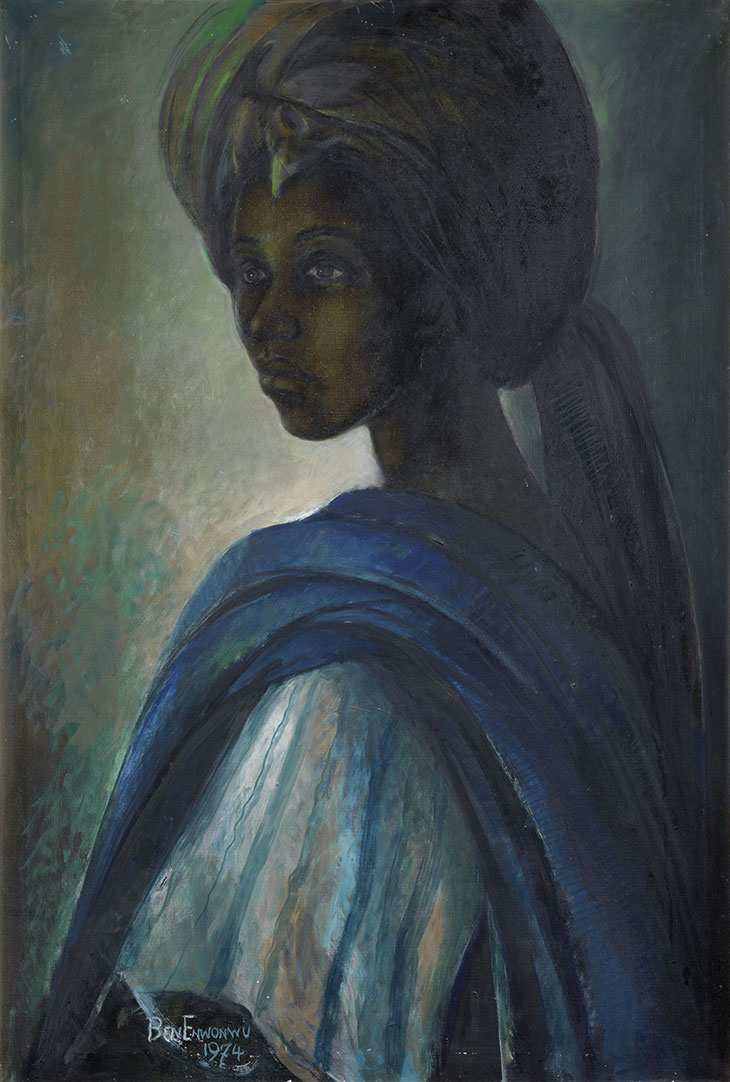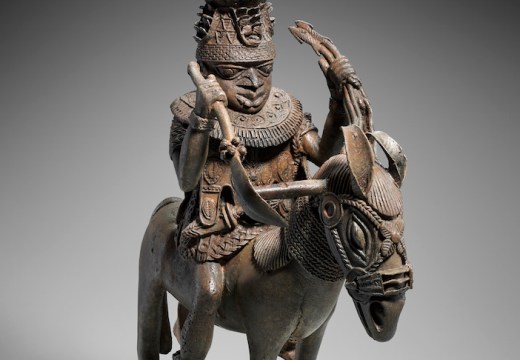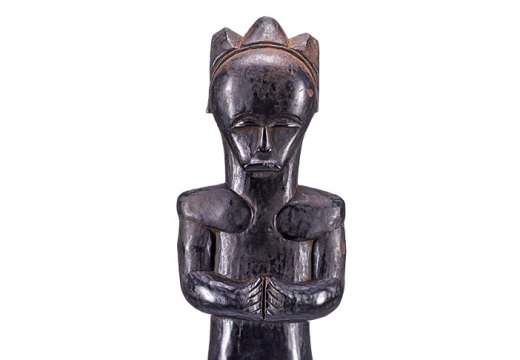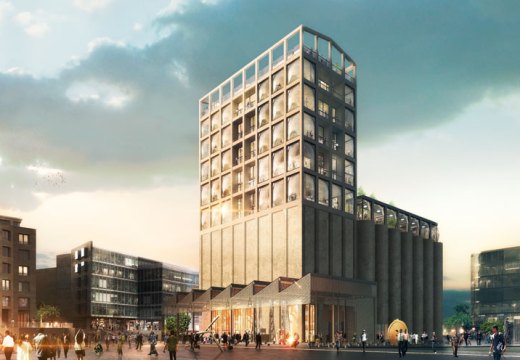‘Before the British came with writing,’ says Cosmos, our guide at the National Museum in Lagos, ‘carving was our information.’ He gestures towards a group of doorposts and panels, which, with their exquisitely rendered motifs of fish, tortoises, and weaponry, would once have identified the owners of the huts they adorned, advertising their expertise as hunters or as fishermen like modern storefront signs.
With its panoply of masks, costumes, votive statues and functional objects, mapping out the rituals and practices that once governed every facet of community life, the museum is a treasure-house of ‘information’ about Nigeria’s past. Unfortunately, the building itself is in poor repair. The flaking paintwork and fickle overhead lights make one painfully aware that little serious work has been done to the building since it opened in 1957. With no air conditioning to protect them from the humidity, the treasures housed here are at risk of decay.
When I visit in early November, however, I am led across the crumbling courtyard into a well-lit, freshly painted space, where an exhibition of works by Oseloka Osadebe (b. 1934) has recently opened. A key figure in the Zaria Art Society of the late 1950s, which sought to fuse Western modernism with forms developed from various styles of traditional carving in the region, Osadebe has never had a retrospective in Nigeria until now. Perhaps this should come as no surprise – the painter emigrated in 1965 to the United States, where he still lives and paints, and from where almost all of the works on display have been shipped. More than two years in the making, this exhibition of around 65 artworks represents a remarkable first opportunity for Lagosians to see Osadebe’s paintings. Early student copies after Matisse’s odalisques and Balla’s coiling Futurist patterns prefigure the artist’s later and more mature explorations of the traditional uli aesthetic of the Igbo culture, notable for its sinuous, circular motifs, which invoke spiritual notions of cyclicality and renewal. Yet there is also a more worldly kind of regeneration at play here, part of the impetus for this exhibition. ‘By bringing this historic exhibition here,’ explains Sandra Mbanefo Obiago, the curator of the show and director of SMO Contemporary Art gallery, ‘we’re getting a new audience to come to the museum.’

Tutu (1974), Ben Enwonwu. Courtesy Bonhams
Art is everywhere in Lagos. Murals decorate the tailgates of the cars and vans that rumble past; as I’m driven past bus stops and beneath the bridges yoking together the many islands of this sprawling oceanside metropolis, I catch glimpses of painted scenes from Yoruba mythology. Painting and sculpture is an integral part of the city’s atmosphere – it melds with the heat of the sun, the busy roads and the shouts of the street hawkers who weave their way through the traffic. However, the lack of an art market in West Africa has long meant that once artists here have made a name for themselves, the bulk of their best work has ended up in the hands of international collectors. The lack of quality art schools, meanwhile, has seen many of the most significant artists following Osadebe’s example and seeking their fortunes overseas. Exhibitions like those organised by SMO, with the costs they are bound to incur, have been few and far between.
That this is beginning to change is in no small part due to Art X Lagos (2–4 November), West Africa’s first international art fair, now in its third edition. For Tokini Peterside, the fair’s director, ‘waiting for the government to do anything is a mistake’. The trick has been to convince the country’s wealthy corporate sector, who have long felt that Nigerians are interested only in ‘popular’ forms of entertainment such as music and film, that collecting and investing in art is worth their while. Accordingly, the atmosphere at Art X Lagos is more like an arts festival than your average art fair. Children are milling curiously around the paintings. There is a programme of live music, featuring a mixture of Nigeria’s established stars and rising talents. Most significantly, a remarkable proportion of the more than 60 artists showing work here are present at the stands, eager to discuss their art with visitors.
For Nigerian artist Gerald Chukwuma, the fair represents a chance for him to ‘tell his story’. With his large-scale wall carvings, he has long sought, like Osadebe, to repurpose uli iconography. However, the works he presents here include, for the first time, large-scale cast sculptures – mysterious, faceless figures, with rusted metal rods, instruments and jewel-like insignia protruding from their torsos. Together, the story that these works narrate is that of the infamous Igbo Landing of 1803. After the treacherous Middle Passage from Africa, rather than submit to further captivity, a group of slaves drowned themselves off the coast of Georgia, singing: ‘The water spirit brought us here / The water spirit shall take us home.’ The spiralling forms of the figures in Chukwuma’s carvings are fleshed out with scraps of tin cans – the artist explains that there is a link between his art as a form of environmental awareness, and as a means of recycling the past so that it speaks the present.
Many of the artists on show here share this concern – Cyrus Kabiru, for instance, an up-and-coming artist from Nairobi, makes intricate spectacle-frames out of trash – but I come across its most striking expression in an annexe of Nike Okundaye’s art gallery in Lekki, a short drive from the fair on Victoria Island. The annexe contains two guesthouses, where almost every inch of wall is covered with contemporary African painting, and on each nightstand I find a precolonial carving, fitted out with lampshade and light bulb. In one instance, a hollow bowl held by a Gabonese Fang figure, which may once have served as a mortar for grinding magical substances, now holds two TV remotes.
For Okundaye, the way to ensure the continual renewal of the past is by ensuring its presence in the everyday. She has been raising awareness of traditional Yoruba adire textiles for half a century – the paintings she shows at the fair, collaborations with the artist Tola Wewe, combine patterns and textures she has adapted from adire styles with Wewe’s Yoruba figures and symbols.
When Okundaye established her first art centre in Lagos in 1983, to provide a home and opportunities for 20 vulnerable girls living on the streets, she tells me that the most she would get from visitors for her efforts was a shake of the hand, and a brusque ‘Good work’. Nowadays, she feels that art has become a viable path – her four-storey, palatial art gallery, now crammed with between 12,000 and 14,000 artworks, is testament to this.
During the fair’s talks programme, where plans are discussed for the country’s first privately owned museums in Lagos and in Onitsha, the artist and art historian Peju Layiwola says: ‘Nike Art Gallery is our National Gallery.’ Despite the lack of support from the government, there are individuals committed to preserving Nigeria’s cultural history, and repurposing it for the future. Perhaps the most powerful symbol of this is the display, at Art X Lagos, of Ben Enwonwu’s portrait of Adetutu Ademiluyi (‘Tutu’), a princess of Ife, which was painted in 1974. For some in Nigeria, it is a powerful emblem of a country coming to terms with the brutal Biafran War, which brought the cosmopolitan atmosphere of the immediate postcolonial period (in which modernist movements such as the Zaria Rebels thrived) to an abrupt close. This seminal work was lost for four decades, until last year it was discovered to have been hanging in a London flat all along. The painting is here only for the opening ceremony – it was snapped up for a record price for an African painting at auction in February, shortly after its rediscovery. Still, for the thousands of Nigerians who pass through the fair, this is the first opportunity since 1975 to meet Tutu’s serene, oblique gaze. It is to be hoped that the cultural renaissance that is apparent everywhere in Lagos will soon lead to the renovation of Nigeria’s museums, and to more permanent homecomings.
From the December 2018 issue of Apollo. Preview and subscribe here.
Unlimited access from just $16 every 3 months
Subscribe to get unlimited and exclusive access to the top art stories, interviews and exhibition reviews.














![Masterpiece [Re]discovery 2022. Photo: Ben Fisher Photography, courtesy of Masterpiece London](http://www.apollo-magazine.com/wp-content/uploads/2022/07/MPL2022_4263.jpg)
Is the Stirling Prize suffering from a case of tunnel vision?